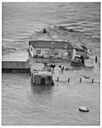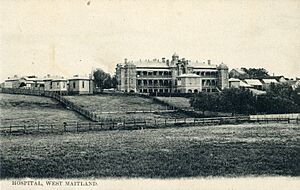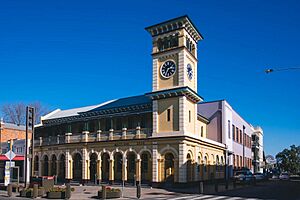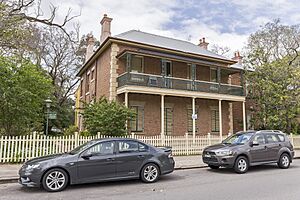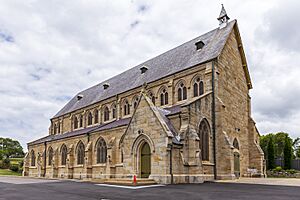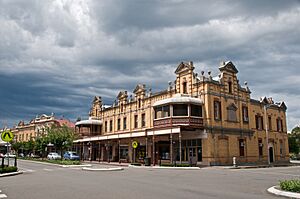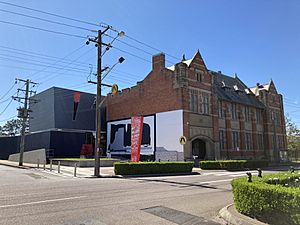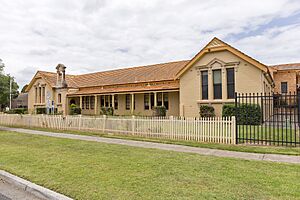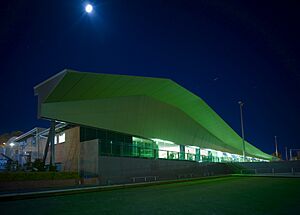Maitland, New South Wales facts for kids
Quick facts for kids MaitlandNew South Wales |
|||||||||
|---|---|---|---|---|---|---|---|---|---|

From top, left to right: Maitland Court House, The Levee, Maitland Post Office, St Mary's the Virgin Anglican Church, Citizens Memorial at Maitland Park
|
|||||||||
| Population | 89,597 (2021 census) | ||||||||
| • Density | 230/km2 (600/sq mi) | ||||||||
| Established | 1820 | ||||||||
| Postcode(s) | 2320 | ||||||||
| Elevation | 3 m (10 ft) | ||||||||
| Area | 392 km2 (151.4 sq mi) | ||||||||
| Time zone | AEST (UTC+10) | ||||||||
| • Summer (DST) | AEDT (UTC+11) | ||||||||
| Location | |||||||||
| LGA(s) | Maitland City Council | ||||||||
| Region | Hunter | ||||||||
| County | Northumberland | ||||||||
| Parish | Maitland | ||||||||
| State electorate(s) | Maitland | ||||||||
| Federal Division(s) | |||||||||
|
|||||||||
Maitland is a city in the Hunter Valley of New South Wales, Australia. It is the main town for the Maitland City Council. The city is located on the Hunter River. It is about 166 kilometres (103 miles) north of Sydney. It is also about 35 kilometres (22 miles) north-west of Newcastle.
In 2021, about 89,597 people lived in Maitland. The city covers an area of 392 square kilometres (151 square miles). Most people live along the New England Highway. This road runs between the suburbs of Lochinvar and Thornton. The city centre is on the right bank of the Hunter River. A levee protects it from floods. Nearby cities include Cessnock and Singleton.
Contents
History of Maitland
The Wonnarua People were the first known people to live on this land. They called the area where Maitland is now, Bo-un. This name came from a type of bird.
Around 1816, European settlers from Newcastle came to the area. They were cutting down cedar trees. In 1818, Governor Lachlan Macquarie visited the area. He named it Wallis Plains after Captain James Wallis. Captain Wallis was in charge of the Newcastle penal colony. In 1819, farmers who were convicts were allowed to choose land at Wallis Plains. One famous farmer was Molly Morgan.
By 1821, the first British government buildings were built. These included a small house and barracks. In 1823, James Mudie helped build a wharf. Two years later, William Powditch opened the first general store.
In 1829, a surveyor named George Boyle White planned a town at Wallis Plains. The village was named Maitland. This was possibly to honour Frederick Lewis Maitland. As more people moved there, Maitland was split in 1835. It became West Maitland (the original Wallis Plains) and East Maitland. The nearby town of Morpeth also grew at this time. Morpeth was a port for larger ships. Goods were then moved upriver to West Maitland by smaller boats.
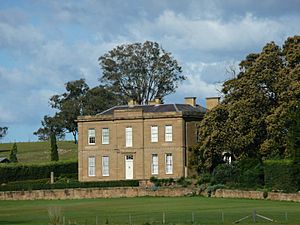
West Maitland became a key place for goods to be unloaded. These goods were then sent to other parts of the Hunter Valley. Large warehouses were built facing the main High Street and backing onto the Hunter River. The arrival of the railway from Newcastle in the 1850s changed things. The river also became more full of dirt, making it harder for large ships. This ended the river trade.
In 1944, West and East Maitland joined together. The name West Maitland officially changed back to Maitland in 1949. The city's borders have grown since then.
The first electricity in the area was connected to Maitland Town Hall in 1922. It powered the front light of the hall.
Belmore Bridge in Maitland

The first bridge connecting West Maitland with Lorn opened in 1869. It was named after the Governor of New South Wales, the 4th Earl of Belmore. This bridge was very important for the city. However, floods in 1893, 1913, and 1930 showed a new bridge was needed. This new bridge had to be strong enough to handle floods.
A second Belmore Bridge was built in 1964. It was designed to withstand the force of flood debris. This new bridge is one of the city's three main river crossings.
Floods in Maitland
Maitland is close to the Hunter River. This has caused many floods since Europeans settled here. Over 200 floods have happened on the Hunter River. Thirteen of these floods were higher than the river's normal peak. All of these 13 floods directly affected Maitland.
Between 1830 and 1834, Maitland had five floods. The 1832 flood was very serious. Water reached about 8.84 metres (29 feet) high and seven people died. In 1857, the Hunter River rose to a record height of 9.2 metres (30 feet).
The 1940s and 1950s saw more rain and the river rose often. In February 1955, Maitland had its worst flood in recorded history. This flood is known as "The Maitland Flood." It was the first Australian natural disaster shown by media around the world. The water reached 12.5 metres (41 feet) high. It caused huge damage. About 7,000 buildings and homes were damaged. Fourteen people lost their lives.
In June 2007, a strong weather system caused major flooding. This affected the lower Hunter Region, including Maitland. The Hunter River was expected to reach 11.3 metres (37 feet) at Belmore Bridge. About 4,000 people from Lorn were moved to safety. Central Maitland was not flooded. However, homes in Branxton, Louth Park, and Raymond Terrace were flooded.
From April 20 to 22, 2015, heavy rain caused flash flooding. Over 200,000 homes lost power. Maitland was badly hit. Flood gates at Maitland railway station were made stronger with sandbags. This stopped central Maitland from flooding. Four people died from the storms. The towns of Dungog and Gillieston Heights were also badly affected.
Jewish Community in Maitland
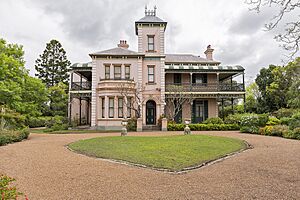
The Maitland Jewish Cemetery is in Louth Park. It is one of only two Jewish cemeteries outside of Sydney in New South Wales. This shows that there was an active Jewish community in Maitland until the 1930s. Between 1846 and 1934, 53 Jewish people were buried there. The former Maitland Synagogue on Church Street was a place of worship. About 70 families used it between 1879 and 1898.
Maitland Hospital
The Immigrants Home in East Maitland was the first public building to treat sick people. It was started by Caroline Chisholm. This site later became the Maitland Benevolent Asylum. In 1835, with a population of 1,900, people asked for a new hospital. A committee was formed and received money for a new hospital in 1844.
The foundation stone for the new hospital was laid in 1846. The hospital officially opened in 1850. In its first year, it treated 231 patients. Between 1903 and 1905, Ward Block 1 was completed. As the population grew, more space was needed. A new building opened in 1905. In 1916, a blood bank was added. In 1926, the hospital became a training school for nurses. New nurses' quarters were built from 1927 to 1928. More extensions were added in the 1930s.
The Addison Building (Ward Block 2) was built between 1942 and 1947. New nurses' homes were built in 1960. In 1973, a new pathology building opened. From 1975 to 1979, new facilities like a boilerhouse and workshops were built. The kitchen and cafeteria were also updated.
The hospital received money from donations and state funds. In 1847, Governor Sir Charles Fitzroy visited the hospital. He gave a donation of £10.
Heritage Sites in Maitland
Maitland has many places listed for their historical importance. These include:
- Church Street: Brough House
- 47 Church Street: Maitland Synagogue
- 66 Church Street: St Mary's the Virgin Anglican Church
- 71 Church Street: Grossmann House
- 12–14 Free Church Street: Presbyterian High School
- High Street: Maitland Court House
- High Street: Maitland Town Hall
- 381 High Street: Maitland Post Office
- 473 High Street: Barden and Ribee Saddlery
- 516 High Street: Department of Mineral Resources Historic Photographs Collection
- Main Northern railway: Maitland railway station
- 34 Regent Street: Cintra House
- 5 Victoria Street: Maitland Lodge of Unity Masonic Hall and Lodge
Maitland's Population
According to the 2021 census, there were 89,597 people in Maitland.
- Aboriginal and Torres Strait Islander people made up 7.7% of the population.
- 86.9% of people were born in Australia.
- The next most common countries of birth were England (1.8%) and New Zealand (1.0%).
- 90.4% of people spoke only English at home.
- The most common religions were No Religion (38.5%), Catholic (22.6%), and Anglican (18.2%).
| Historical population | ||
|---|---|---|
| Year | Pop. | ±% |
| 1921 | 12,008 | — |
| 1933 | 12,224 | +1.8% |
| 1947 | 19,151 | +56.7% |
| 1954 | 21,331 | +11.4% |
| 1961 | 22,917 | +7.4% |
| 1966 | 23,118 | +0.9% |
| 1971 | 24,537 | +6.1% |
| 1976 | 36,030 | +46.8% |
| 1981 | 38,865 | +7.9% |
| 1986 | 43,247 | +11.3% |
| 1991 | 45,209 | +4.5% |
| 1996 | 50,108 | +10.8% |
| 2001 | 53,391 | +6.6% |
| 2006 | 61,431 | +15.1% |
| 2011 | 67,132 | +9.3% |
| 2016 | 78,015 | +16.2% |
| 2021 | 89,597 | +14.8% |
| Source: Australian Bureau of Statistics data. | ||
Maitland's Climate
Maitland has a humid subtropical climate. This means it has hot summers and mild to cool winters. Rainfall is highest in summer. The hottest temperature recorded in Maitland was 44.5 °C (112.1 °F). This happened on January 18, 2013, and February 21, 2004. The coldest temperature was −4.5 °C (23.9 °F) on August 24, 2003. The average yearly rainfall is 837.5 millimetres (32.97 inches). On average, Maitland has 90.3 clear days each year.
| Climate data for Maitland Visitors Centre (1997–2016) | |||||||||||||
|---|---|---|---|---|---|---|---|---|---|---|---|---|---|
| Month | Jan | Feb | Mar | Apr | May | Jun | Jul | Aug | Sep | Oct | Nov | Dec | Year |
| Record high °C (°F) | 44.5 (112.1) |
44.5 (112.1) |
40.0 (104.0) |
36.0 (96.8) |
29.5 (85.1) |
24.6 (76.3) |
24.8 (76.6) |
30.5 (86.9) |
35.2 (95.4) |
39.5 (103.1) |
43.0 (109.4) |
42.2 (108.0) |
44.5 (112.1) |
| Mean daily maximum °C (°F) | 30.2 (86.4) |
29.4 (84.9) |
27.7 (81.9) |
24.6 (76.3) |
21.4 (70.5) |
18.4 (65.1) |
18.0 (64.4) |
20.0 (68.0) |
23.2 (73.8) |
25.7 (78.3) |
27.0 (80.6) |
28.8 (83.8) |
24.5 (76.1) |
| Mean daily minimum °C (°F) | 18.2 (64.8) |
18.1 (64.6) |
16.1 (61.0) |
12.4 (54.3) |
8.4 (47.1) |
6.6 (43.9) |
5.4 (41.7) |
5.6 (42.1) |
8.4 (47.1) |
11.0 (51.8) |
14.5 (58.1) |
16.4 (61.5) |
11.8 (53.2) |
| Record low °C (°F) | 8.4 (47.1) |
9.8 (49.6) |
7.0 (44.6) |
0.7 (33.3) |
−0.9 (30.4) |
−1.8 (28.8) |
−3.5 (25.7) |
−4.5 (23.9) |
0.0 (32.0) |
3.0 (37.4) |
3.4 (38.1) |
5.3 (41.5) |
−4.5 (23.9) |
| Average precipitation mm (inches) | 78.0 (3.07) |
104.6 (4.12) |
85.5 (3.37) |
94.0 (3.70) |
59.0 (2.32) |
85.1 (3.35) |
42.5 (1.67) |
35.7 (1.41) |
48.1 (1.89) |
56.4 (2.22) |
81.0 (3.19) |
67.6 (2.66) |
838.1 (33.00) |
| Average precipitation days | 10.8 | 11.3 | 11.2 | 12.0 | 10.2 | 12.8 | 9.8 | 8.3 | 8.8 | 8.9 | 12.0 | 10.5 | 126.6 |
| Average afternoon relative humidity (%) | 52 | 58 | 59 | 58 | 57 | 61 | 57 | 48 | 48 | 50 | 54 | 52 | 55 |
| Average dew point °C (°F) | 16.9 (62.4) |
18.0 (64.4) |
16.6 (61.9) |
13.4 (56.1) |
10.4 (50.7) |
9.0 (48.2) |
7.5 (45.5) |
6.6 (43.9) |
8.9 (48.0) |
11.0 (51.8) |
13.7 (56.7) |
15.5 (59.9) |
12.3 (54.1) |
Maitland's Economy
Shopping in Maitland
Maitland has many places to shop. These include Stockland Green Hills in East Maitland and Centro Maitland Hunter Mall. The High Street Mall is in the City Centre. Rutherford, Melbourne Street, and Lawes Street (East Maitland) also have shops. Morpeth, a suburb of Maitland, is popular for its fashion shops, cafes, and special stores.
Transport in Maitland
Buses
Bus services in Maitland are run by Hunter Valley Buses and Rover Coaches.
Trains
Maitland railway station is on the Hunter Line and Main Northern line. It is also where the North Coast Line connects. Other train stations in Maitland include:
- East Maitland
- High Street
- Metford
- Mindaribba
- Telarah
- Victoria Street
- Thornton
- Lochinvar
A passenger tram system ran from East Maitland to West Maitland from 1909 to 1926. Buses then replaced it and still run today.
Air Travel
Maitland Airport is a small airfield for general aviation. It is next to the New England Highway at Rutherford. The closest airport for commercial flights is Newcastle Airport in Williamtown.
Media in Maitland
Maitland has several local newspapers, radio stations, and television channels.
Newspapers
The Maitland Mercury and Newcastle Herald are the main newspapers in the city. The Mercury started in 1843. It is Australia's oldest regional newspaper. The Lower Hunter Star is also published every Thursday. It is delivered to most homes in the City of Maitland.
Radio Stations
Radio stations include:
- 2HD (commercial)
- ABC Newcastle (ABC Local Radio)
- Sky Sports Radio (part of a statewide network)
- Triple M Newcastle (commercial)
- hit106.9 Newcastle (commercial)
- New FM (commercial)
- 2NUR (community radio)
- 2CHR (Central Hunter Radio) 96.5 FM – (community radio)
- Rhema FM Newcastle (Christian radio)
- Triple J (Australian Broadcasting Corporation)
Television Channels
Maitland is part of the Newcastle–Hunter Region TV market. It has five television networks:
- Nine, 9Gem, 9Go! and 9Life.
- 10 Northern NSW, 10 Bold and 10 Peach.
- Seven (formerly Prime7), 7two, 7mate, 7Bravo and 7flix.
- Australian Broadcasting Corporation including ABC TV, ABC TV Plus, ABC Kids, ABC ME and ABC News.
- Special Broadcasting Service including SBS, SBS Food, SBS World Movies, SBS WorldWatch, SBS Viceland and NITV.
Nine Northern NSW (as NBN) creates a local news bulletin. It screens every night at 6:00 pm on Channel 9. Other channels also have short local updates. You can also get the subscription TV service Foxtel by satellite.
Theatre
The famous Scottish entertainer Sir Harry Lauder performed in Maitland Town Hall. He had a full audience on August 15, 1925.
Culture in Maitland
Art
Maitland Regional Art Gallery, or MRAG, opened in November 2003. It closed for upgrades in 2008. The artist Margaret Olley reopened it on August 15, 2009.
Library
Maitland and the areas around it are served by the Maitland City Library and its branches.
Annual Events in Maitland
- Hunter Valley Steamfest is a yearly festival. It celebrates the history of steam power and industry in Maitland. It started in 1986.
- Bitter & Twisted Beer Festival is a yearly international beer festival. It is held at the historic Maitland Gaol in East Maitland.
- ChapelJazz (formerly Morpeth Jazz Festival) is a yearly music festival. It takes place in the historic port of Morpeth. It celebrates music, wine, and food.
- Groovin' the Moo is a yearly music festival. It has been held at the Maitland Showground since 2006.
- Maitland Show is a yearly agricultural show. It is held at the Maitland Showground.
Education in Maitland
Maitland has many schools and training centres. The Hunter Institute of TAFE has a campus in Maitland. The Hunter Valley Training Company is also there. These places offer great training in many areas. This includes building, engineering, mining, tourism, and business.
Maitland has twenty primary schools and seven high schools. Local high schools include:
- St Joseph's College, Lochinvar
- All Saints College, St Mary's Campus
- All Saints College, St Peter's Campus
- Hunter Valley Grammar School
- Maitland Christian School
- Maitland Grossmann High School
- Maitland High School
- Rutherford Technology High School
- Francis Greenway High School
There are also many pre-school and day care centres.
Sport and Recreation in Maitland
Maitland has a strong sports community. There are many sports competitions and clubs in the city. These include:
- Maitland FC – A soccer club.
- Maitland Pickers – A rugby league club.
- Maitland Blacks – A rugby union club.
- Maitland Saints – An Australian rules football club.
- Maitland Off-road Radio Car Club, which races at Harold Gregson Reserve.
Maitland Showground is an outdoor area used for many activities. It hosts greyhound racing and harness racing. The site is also famous for motorcycle speedway. The sport began here on December 15, 1923.
Notable People from Maitland
- William Arnott (1827–1901), biscuit maker
- John Bell (1940–), actor
- Greg Bird (1984–), professional rugby league player
- Caroline Chisholm (1808–1877), a kind person who helped homeless immigrants in Maitland
- Abbie Cornish (1982–), actress
- Ruth Cracknell (1925–2002), actress
- Les Darcy (1895–1917), boxer and local hero
- H. V. Evatt (1894–1965), former leader of the Australian Labor Party and important judge
- Allan Grice (1942–), motor racing driver
- Ben Hall (1837–1865), bushranger
- Isaac Heeney (1996–), AFL player
- Charles Macartney (1886–1958), cricketer
- Christian Mansell (2005–), racing driver
- Margaret Olley (1923–2011), painter
- Peter Wynn (1957–), rugby league player
- Hudson Young (1998–), rugby league player





